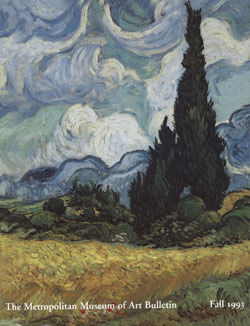Settee
George Jakob Hunzinger American
George Hunzinger was one of the most innovative cabinetmakers of his day. He drew inspiration from both historical sources and modern machinery, and he pioneered novel manufacturing methods, securing at least twenty-one patents. This striking settee, defined by bold geometric shapes, is one of his most progressive designs. It incorporates interchangeable parts and employs an ingenious technique Hunzinger patented in 1876 that involves weaving flat steel wire covered with a continuous woven textile into a grid pattern. The seat, back, and arms are each composed of only two wires, with one running in each direction. Hunzinger proudly asserted that this would ensure "great strength and beauty."
This settee, one of only two known examples of this kind, was part of a suite of furniture Hunzinger made that included two armchairs, four side chairs, and a table. Hunzinger was a pioneer in the use of interchangeable parts and drew directly from his design for the settee to create the armchairs and side chairs. Born in Tuttlingen, Germany to a family of furniture makers dating back to the seventeenth century, Hunzinger continued this line of work after immigrating to the United States. Embracing the efficiencies of industrialization, Hunzinger produced relatively inexpensive and high-quality furniture accessible to middle-class Americans. This settee employs Hunzinger’s sixth patent for its woven wire upholstery, which modified Chester D. Flynt’s 1876 patent intended for "Improvement in Carriage-Seats." Inspired by that patent’s use of wire bands, Hunzinger saw continuous flat steel wiring as an alternative to furniture canning and patented his own technique later that year.
Due to rights restrictions, this image cannot be enlarged, viewed at full screen, or downloaded.


